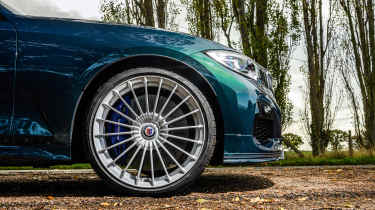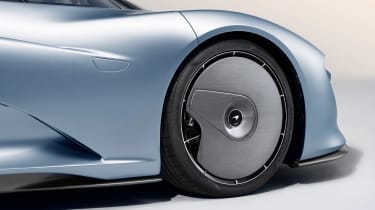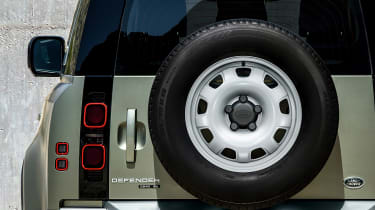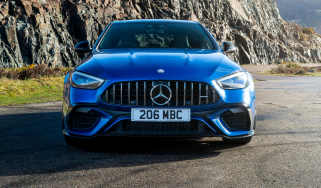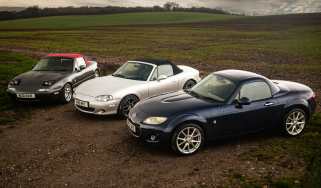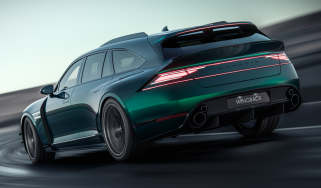How to design a car (part one): wheels and tyres
In the first part of a new series looking at all aspects of car design, Peter Stevens ponders the importance of wheels and tyres to both engineering and aesthetics
The wheel and tyre package is what defines the car as being a land-based machine; those four perfectly circular elements are fundamental to telling us what it is that we are looking at. That sounds obvious, but this brilliant, probably 3000-year-old invention immediately implies motion.
The origins of today’s alloy wheels are now 80 years distant. Aircraft experience during the Second World War led to the development of magnesium race car wheels by Halibrand in America, whilst in the UK in the 1950s Dunlop produced cast aluminium alloy race wheels for Jaguar.
By the 1980s, cast alloy wheels were either optional extras or, on high performance cars, part of the standard specification of the vehicle. These were simple times when by looking at the wheel/tyre combination you could tell what the purpose of the car was. Chunky 15in steel wheels and knobbly tyres said ‘off-road use’, skinny 13in wheels with plastic wheel covers shouted ‘city car’, 15s or even 16s suggested something a little bit sporty, whilst 18in wheels, as were fitted to Ferrari or the McLaren F1 were seen as ultra high-performance indicators.
> Blue brakes and an evo Nürburgring gathering – evo Archive
When I worked in the studio as chief designer at Lotus in the ’80s, we were just starting to develop a sketching style where we exaggerated the wheel diameter of our proposals to give the designs more dynamism. There was a senior engineer who would come into a design presentation with a little 6in steel rule and a slide rule (pre-calculator days!) and measure our sketches. He would delightedly crow that we were proposing 16in diameter wheels, an engineering impossibility! Very much like when I fitted an MG TF with 17in wheels in the dying days of MG Rover after being told again it was impossible!
The problem with casting alloy wheels is that you can make almost any shape that the tool-maker has the skill to produce. I have always felt that an even number of spokes, four and eight in particular, looks static when a wheel should look dynamic. That said, Ronal once sold a five-spoke teddy bear wheel where the head, paws and feet were what joined the rim to the hub! Before designers had CAD it was quite difficult to sketch a convincing five-spoke wheel; working out a spacing of 72 degrees between spokes in perspective took some practice.
Back in the days when I was involved in helping to run Porsche’s 962 Le Mans cars, they came with BBS split-rim alloy wheels, where the rims were spun aluminium while the centres were in the classic BBS cast alloy style. BBS also supplied some beautiful outer plastic wheel discs that had dozens of little turbine-like vanes on the back surface. The rotating discs pulled large amounts of air past the brakes and were supposed to help brake cooling, but we quickly found that they could affect the aerodynamic balance of the car. You could use them to fine-tune either understeer or oversteer with no increase in aero drag. It amused me to see McLaren fitting something similar to the front wheels of its Speedtail, although strangely those covers are stationary, being fixed to the stub-axle.
The important thing for a designer to remember is that wheels are principally engineering components; their secondary purpose may be style-related as an indicator of the car’s purpose. And their weight is crucial to the ride, handling and feel of the car’s steering. How often do we read evo road testers saying they preferred the messages that came from the smaller diameter rims.
The centre of the wheel where it bolts to the hub is the most highly loaded part of the wheel. All those acceleration, braking and, most importantly, side forces from the tyres are transmitted through the wheel bolts to the hubs and suspension. Spokes that look like flower petals have all their strength and weight at the rim where it is least needed; spokes that do not feed their loads directly to the mounting bolts contribute to a wheel that is heavier than it needs to be, too.
It is a simple engineering fact of life that an 18 or 19in wheel is the best compromise between tyre stiffness, air volume and wheel weight. Very large diameter wheels with 8, 9 or 10in wide rims to suit giant low-profile tyres are very heavy. This is partly because, with modern suspension geometry, the inner part of the rim overhangs the hub to such a degree that the inside edge of the rim is easily damaged or becomes oval after hitting a pothole. To protect from this unseen damage, the rims are much thicker than those of an 18in rim, again adding to their weight. The new Land Rover Defender has 18in diameter wheel rims as a minimum, the best looking being the white painted steel version; 22in rims are an option. What kind of message does this give when it is well known that what is needed for serious off-road work is a 235/85 profile 16in wheel such as is offered by Jeep. It is not possible to fit 16in rims to a Defender.
There is no doubt that big wheels with low-profile tyres look so much better on most modern cars than fat tyres on little wheels. The big wheels take on more importance within the body design; they suggest a serious purpose. But too big and the car can look ridiculously out of proportion. Black wheels can look good at a car show but tend to disappear at a distance; white wheels, like white socks, look totally 1980s; silver is always a safe bet, but satin gunmetal rims can give a tough sinister impression to a lowered car (kind of a Miami drug dealer look). Diamond-cutting the rim and spoke details always looks a bit naff to me and if you live near the sea they rapidly grow white fur!
The wheels that look best usually have just five spokes and are simple, graphic images with very little fussy detail – for example, early BBS wheels. Tesla wheels look so heavy, but then the car is heavy, while Alpina multi-spoke wheels for BMWs look super-light. For some reason manufacturers think that electric cars need wheels that look like they belong to a domestic household appliance, imagining that they shout ‘hey look, I’m electric’.
There is a recent trend among design students and designers, when sketching new cars, to forget the rims completely and just draw enormous spokes. Official Porsche sketches of the new Cayenne show exactly this style and you can buy Wolfrace Assassins with no apparent rim and spokes like daggers! Seems people are always looking for ways to reinvent the wheel…
